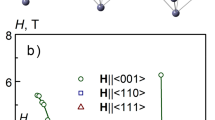Conclusion
Experimental data obtained in the present work provide evidence for the fact that in magnetic dielectrics with competing exchange interactions, and in particular, in compounds with the garnet structure, various disordered phases of the spin glass type may be realized. The peculiarity of these phases lies in the fact that they occur in magnetically concentrated systems, and their nature is not related to any of the mechanism of spin glass state noted in the introduction. For this reason, physical properties of solid solutions of antiferromagnetic garnets, in which spin glass state is observed, apparently, differ from the corresponding characteristics of “traditional” spin glasses. In particular, our measurements have shown that the character of the maximum in χ′ dependence in MnFeG does not depend on whether the sample was cooled in a magnetic field below To or in the absence of the field. We were also not successful in observing any signs of relaxation behavior in MnFeG magnetization when the field was turned on and off. In CaFeCrG, there is no frequency dependence of the maximum of χ′(T).
On the other hand, the microscopic mechanism of formation of a spin glass state in the garnets studied is undoubtfully related to frustrations which occur because of the peculiar topology of exchange interactions in the garnet structure. In this sense, MnFeG, CaFeCrG, and MnFeCrG may be characterized as topological spin glasses occurring in solid solutions of those antiferromagnetic garnets which have different propagation vectors of magnetic structures.
In conclusion, we note that results that we have obtained point to the existence in solid solutions of magnetic dielectrics with antiferromagnetic exchange interactions of compounds with qualitatively new, peculiar magnetic properties, and from this point of view it is of great interest to study them further.
Similar content being viewed by others
Literature cited
J. Villain, Z. Phys.,B33, 31 (1979).
A. N. Christensen, T. Johansson, and B. J. Lebech, J. Phys.,C9, 260 (1976).
H. Dachs and W. Kurtz, J. Magn. Magnetic Materials,4, 262 (1977).
K. Katsumata, M. Kobayashi, T. Sato, and Y. Miyako, Phys. Rev.,B19, No. 5, 2700 (1979).
K. Katsumata, T. Nire and M. Tanimoto, Phys. Ref.,B25, No. 1, 428 (1982).
F. Fiorani, S. Viticoli, J. L. Dormann, J. L. Tholense, J. Hamann, and A. P. Murani, J. Phys.,C16, 3175 (1983).
L. De Seze, J. Phys.,C10, 23 (1977).
E. F. Shender, Zh. Eksp. Teor. Fiz.,75, No. 1, 352 (1978).
M. Escorne, A. Mayger, R. Triboulet, and J. L. Tholense, Physica,B107, 309 (1981).
F. Sholl and K. Binder, Z. Phys.,B39, No. 3, 239 (1980).
K. P. Belov and V. I. Sokolov, Usp. Fiz. Nauk,121, No. 2, 285 (1977).
T. V. Valyanskaya and V. I. Sokolov, Zh. Eksp. Teor. Fiz.,75, No. 1, 325 (1978).
I. V. Golosovskii and V. P. Plakhtii, Preprint of the B. P. Kostantinov Leningrad Institute of Nuclear Physics of the Academy of Sciences of the USSR, No. 374 (1977).
I. V. Golosovskii, V. P. Plakhtii, et al., Fiz. Tverd. Tela,19, No. 4, 1181 (1977).
W. Prandl, Solid State Commun.,11, No. 5, 645 (1972).
V. I. Sokolov and O. I. Shevaleevskii, Zh. Eksp. Teor. Fiz.,72, No. 6, 2367 (1977).
W. Prandl, Solid State Commun.,11, No. 6, 529 (1972).
R. Plumier, Solid State Commun.,10, No. 1, 5 (1972).
S. J. Smart, Effective Field Theories of Magnetism, Saunders (1966).
R. M. Bozorth and S. Geller, J. Phys. Chem. Solids,11, No. 3/4, 263 (1959).
L. E. Wenger and P. H. Keesom, Phys. Rev.,B13, No. 9, 4053 (1976).
R. G. Bowers and M. E. Wolf, Phys. Rev.,177, No. 2, 917 (1969).
V. A. Povitskii, F. J. Litterst, and E. F. Macarov, J. Physique,41, Suppl. C1, No. 1, 183 (1980).
O. P. Smirnov, V. P. Plakhtii, and I. V. Golosovskii, Fiz. Tverd. Tela,26, No. 2, 551 (1984).
V. P. Plakhtii, I. V. Golosovskii, et al., Pis'ma Zh. Eksp. Teor. Fiz.,16, No. 5, 276 (1972).
K. P. Belov, Ferrites in Strong Magnetic Fields [in Russian], Nauka, Moscow (1972).
S. A. Bogoslovskii, T. V. Valyanskaya, et al., Fiz. Tverd. Tela,25, No. 2, 328 (1983).
K. M. Kherd, Usp. Fiz. Nauk,142, No. 2, 331 (1984).
Author information
Authors and Affiliations
Additional information
Translated from Izvestiya Vysshikh Zavedenii, Fizika, No. 10, pp. 91–104, October, 1984.
Rights and permissions
About this article
Cite this article
Sokolov, V.I. Concentrated spin glass state in solid solutions of antiferromagnetic garnets. Soviet Physics Journal 27, 881–893 (1984). https://doi.org/10.1007/BF00891496
Issue Date:
DOI: https://doi.org/10.1007/BF00891496




